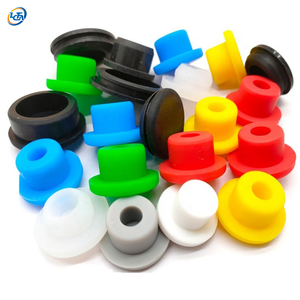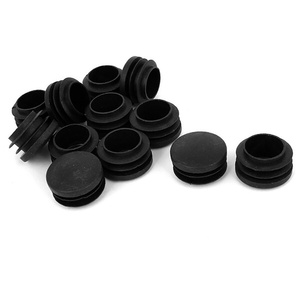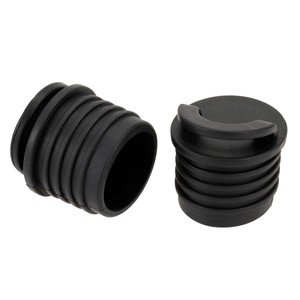
All categories
Featured selections
Trade Assurance
Buyer Central
Help Center
Get the app
Become a supplier

(1345 products available)














































10mm rubber plugs come in different types and are suitable for diverse applications. They serve a common purpose, which is to provide effective sealing, filling holes, or inserting into objects. Knowing the types ensures the right 10mm rubber plug is picked out for any given project.
The simple standard rubber plug consists of a basic design and is used for general sealing purposes. Normally, this type of plug is employed in applications where there is low-stress exposure to fluids or gases. Cemented into holes or openings, they prohibit unwanted elements from entering.
Inflatable rubber plugs are distinctive since they are compressible. This characteristic allows them to adapt for use in varying diameters of pipe or hole dimensions. Currently, these plugs are utilized within plumbing and pipelines, where suitable sealing is essential. When the plug is inflated, it establishes a tight seal that stops fluid passage.
Tapered rubber plugs feature a conical shape that allows for better sealing in uneven surfaces or tapered holes. This makes them suitable for more complex surfaces than cylindrical straight holes. Grading rubber plugs are extensively used in automotive and machinery maintenance environments. This is where better sealing is required in irregular openings.
Rubber plugs with strings attached include a rubber plug with an attached pull string or a retrieving cord. Thus making recovery easier once the plug is pulled out. This kind of plug is widely used in metal casting processes. In casting, the plugs are used in the creation of voids or holes in concrete structure elements.
When choosing a 10mm rubber plug, there are crucial specifications to consider. Part specifications include shape, hardness, and tensile strength. These ensure compatibility with the application's requirements and demands.
Durometer Hardness
Durometer hardness refers to a measure of a material's firmness. This is oftentimes measured using a durometer gauge. For rubber plugs, the uprange of durometer hardness is between 30 to 70 Shore A. Plugs with lower durometers offer flexibility and ease of deformation under pressure. Higher durometers tend to provide more rigidity and are commonly suitable for heavy-duty applications.
Tensile Strength
Tensile strength is the measure of how much force a material can withstand when being pulled apart. For rubber plugs, the suitable tensile strength is between 6 to 15 MPa. Plugs with higher tensile strength are better suited to applications involving stretch or mechanical stress. For example, in high-pressure sealing environments.
Shape and Size
10mm rubber plug shape and size determine its compatibility with the specific holes or openings. Standard plugs have cylindrical shapes, while tapered plugs provide conical shapes. Thus, the 10mm size ensures that the plug fits in 10mm diameter holes. This gives room for effective sealing.
Surface Texture
The surface texture of a rubber plug might affect its grip and sealing capability. Therefore, plugs with smooth surfaces create less friction during insertion. However, textured surfaces might enhance grip. This is especially true in wet or oily conditions.
Temperature Resistance
Temperature resistance indicates how much heat or cold a material can withstand without degrading. Generally, rubber plugs are ideal for applications to be exposed within -40°C to 100°C. Silicone rubber plugs can easily withstand this range due to their excellent thermal properties. On the other hand, Nitrile rubber plugs are better suited for applications involving oils and fuels. This is because they can withstand up to 90°C.
A 10mm rubber plug is versatile and finds wide applications in numerous industrial and commercial scenarios. Understanding the diverse applications helps in appreciating the role these plugs play in their operations.
10mm rubber plugs are commonly used in the automotive industry for sealing holes. Especially where the internal parts need to be protected from dirt and moisture. In this automotive, these plugs are used to fill unused holes in car frames and prevent rust accumulation. In car engines, they are used to seal internal components as well as provide a dust-free environment.
In manufacturing, particularly in metalwork, the plugs with strings have pivotal roles during casting processes. These plugs generate voids for essential features in cast parts. Moreover, in machinery assembly, 10mm rubber plugs are used to fill holes or provide insulation between components. This reduces vibration and enhances machinery performance.
Inflatable rubber plugs find their wide use in plumbing. These plugs are used temporarily to stop water flow through pipes during repairs. This allows plumbers to carry out necessary work without the pipe system experiencing water flow interruption. Their adaptability to different pipe diameters makes them indispensable in plumbing maintenance.
In the construction business, 10mm rubber plugs are used to fill holes in concrete or masonry. This is needed after installing fittings like anchors or dowels. Thus, they offer a simple yet effective way of achieving a well-finished surface in masonry. Moreover, these plugs provide insulation and isolation between different building components.
In electronics, specifically in devices with sealed compartments, 10mm rubber plugs are used to prevent moisture and dust from entering the device. They are commonly used in electrical boxes, circuit boards, and other sensitive devices, For these applications, the durability and elasticity of rubber make it highly appropriate for use in this sealing.
Choosing the right 10mm rubber plug for a given application needs careful consideration of several key factors. These factors include the material, plug type, and operational conditions. Below is a comprehensive list of these factors.
Material Composition
The main reason is that different rubber materials possess unique properties. For instance, Nitrile rubber plugs prove particularly resistant to oils and fuels. Therefore, making them ideal for the automotive and chemical industries. Silicone rubber plugs have excellent temperature resistance properties. They can function within a broad temperature range. Therefore, these plugs are ideal for use in ovens, engines, and other high-heat environments.
Type of Plug
There are two common types of plugs: tapered and cylindrical. Tapered plugs provide better sealing on uneven surfaces or in holes that are not perfectly straight. On the other hand, cylindrical plugs are used for standard hole filling where no extra sealing is required. Choosing between these two varieties depends mainly on the surface type and the sealing requirements.
Application Requirements
Consider the specific needs of the application that is at hand. If the application in question is chemical exposure or extreme temperature difficulties, then a Nitrile or silicone rubber plug is most suitable. On the other side, standard rubber plugs can suit general-purpose tasks where low-stress situations are experienced.
Load Conditions
It is also necessary to consider mechanical and pressure loads that the plug will bear. In high-pressure environments, rubber plugs with greater tensile strength and durometer hardness should be used. They can withstand mechanical stress as well.
A1: 10mm rubber plugs are generally used to fill holes, seal openings, or provide cushioning in various applications. Their versatility makes them suitable for many industrial and commercial uses.
A2: The common materials for 10mm rubber plugs are Nitrile, silicone, and natural rubber. Nitrile rubber plugs are highly resistant to oils and chemicals. Thus, making them ideal for automotive and industrial uses. Silicone rubber plugs have an exceptional temperature resistance. This enables them to be used in high-heat environments, such as ovens and engines.
A3: It is important to consider the kind of environment in which the plug will be used. This is because silicone plugs are ideal for extreme temperatures and chemical exposure. Nitrile plugs are better for environments that involve frequent exposure to fuels and oils.
A4: This is normally dependent on the kind of application and how the plugs have been used. For example, rubber plugs used in low-stress sealing applications can be reused multiple times without any deterioration in performance. However, in high-stress environments, the plugs might wear out faster, hence reducing their reusability.
A5: Tapered plugs provide conical sealing in uneven surfaces. This makes them more appropriate for applications with holes that are not straight and require more intricate sealing. Cylindrical plugs, on the other hand, are more ideal for standard filling holes.